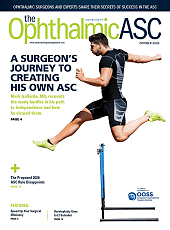At the 2025 annual meeting of the American Society of Ophthalmic Administrators/American Society of Cataract and Refractive Surgery (ASOA/ASCRS) in Los Angeles this past April, administrators, physicians, and industry representatives from around the country came together to examine a shared truth in our profession: that much of our daily work revolves around driving change.
Whether it is introducing new technology, integrating a cash-pay service line, updating workflows, or other initiatives, practice administrators are on the front-lines of turning innovation into everyday operations.
This is where the Aii in Action program comes in. Aimed at fostering successful adoption, implementation, and integration (Aii) of new products and practices, the framework was created to help administrators take new ideas from conception to execution to sustainability. The program, launched at the Los Angeles meeting, was not just another lecture series—it was a call to action and a practical toolkit for administrators navigating the ever-changing world of ophthalmology.
In this article, I will walk through the Aii model and the 6 infrastructure pillars that support it, share insights from our Los Angeles sessions, and offer a roadmap for bringing the latest technology and services to your patients with clarity and confidence.
Aii: A Framework for Meaningful Change
The Aii program is built around a cycle that mirrors the natural phases of change in a medical practice. This includes:
- Adoption: Securing buy-in and alignment from all levels of the organization: providers, staff, and leadership.
- Implementation: Planning, allocating resources, training, and launching the service or solution.
- Integration: Making the change part of the daily routine—embedded in workflows, culture, and performance metrics.
Too often, practices skip straight to implementation without ensuring adoption or fall short in integration because of insufficient planning. The Aii framework addresses these gaps. It serves as both a checklist and a mindset, helping administrators navigate complex changes without leaving key players or systems behind.
Six Pillars of Infrastructure: A Foundational Checklist
During the ASOA sessions, we introduced 6 pillars of infrastructure that every administrator should evaluate when preparing to launch a new program or technology. These pillars form a foundational checklist that supports successful adoption, implementation, and long-term integration. I will discuss each below.
1. Staffing
Any successful initiative starts with the right people. This means identifying champions of the project and securing buy-in from front-line staff, providers, and a dedicated project manager or lead administrator. Your champions should be empowered to represent their peers, surface concerns, and champion the change.
Buy-in isn’t a one-time conversation—it requires ongoing communication, feedback loops, and transparency.
2. Scheduling
Changes in services or technology almost always impact scheduling. Consider siloed or block scheduling to create predictable service times. Also, consider resource availability, especially in staff (do you have the coverage?) and equipment (do you have enough machines or space to meet demand?). Optimizing your schedule before you go live helps reduce downstream bottlenecks and improves patient and staff satisfaction.
3. Revenue Cycle Expertise
One of the most complex parts of introducing a new service line is figuring out how it will be paid for. Your revenue cycle team should weigh in on the following: cash pay pricing and processes; carrier pay and reimbursement levels; upgrade and combination service options; and compliance, including legal considerations and risk exposure.
Poor planning here can cost your practice time, money, and trust. Align your clinical, administrative, and billing teams early in the process.
4. Facilities
Your physical space must align with your service goals. Consider whether your facilities need: upgrades to support new technology; revisions to your footprint for better patient and staff flow; and allocation between ASC, clinic, or both for the new services.
Also, look at how patients move through your space and whether the new service adds friction or streamlines care. Small changes can make a big impact.
5. Marketing
Even the best service won’t succeed if your patients and referral sources don’t know about it. Your marketing strategy should include: website and SEO updates; social media campaigns; updated brochures, signage, and in-office education; and communication with referral sources and local providers.
Marketing isn’t about a one-time blast—it’s about consistent messaging that reinforces your value to patients and partners alike.
6. Education
The most overlooked pillar—education—must include every stakeholder. This includes: providers; technicians; front desk and call center teams; and billing and finance. Training should include: service knowledge (what, why, and how); and source education (who is a candidate, how are they routed?). In addition, customer service skills, especially for high-value cash services, should be included in training.
We introduced the concept of “Red Carpet Service” during the Aii program—a mindset where cash-pay patients receive exceptional, white-glove care from every touchpoint. This level of service doesn’t just impact conversion; it impacts loyalty and reputation.
Collaboration Is the Catalyst
What makes Aii work in real-world practices isn’t just the framework itself. It’s the collaboration that happens between administrators, providers, staff, and industry partners. None of us can move these initiatives forward in a vacuum.
Administrators bring the operational perspective, ensuring the right systems and processes are in place. Providers offer clinical credibility and help drive adoption through trust and leadership. Staff provide front-line insights into what will work and what won’t. Industry partners bring training, data, and innovation to the table.
When these groups are aligned, change happens faster and more successfully.
Lessons From Los Angeles
Our sessions in Los Angeles were filled with real-world examples, case studies, and discussion. We heard from practices launching new dry eye clinics, introducing premium cataract packages, and onboarding AI diagnostic tools. What united these stories was the emphasis on the process, not just the product.
Several common threads emerged:
- Success begins with setting expectations early and clearly.
- Technology without workflow leads to frustration.
- Reimbursement strategies must be built before service launch.
- Consistent staff education is a game-changer.
- Physical space constraints are often a silent barrier.
These aren’t new truths, but the Aii framework gives practices a way to tackle them systematically, avoiding common pitfalls.
Final Thoughts: Aii Is a Mindset
The most important takeaway from the Aii program is this: Adoption, Implementation, and Integration isn’t a project—it’s a mindset. It’s a way of looking at new ideas with clarity and structure, so we avoid the “shiny object syndrome” and instead build meaningful, lasting change.
As ophthalmology evolves and patient expectations grow, our ability to lead successful transformation will determine whether we stay competitive, compelling, and clinically excellent. Aii gives us the roadmap to do just that. The blueprint is here. It’s time to put it into action. OM
For questions or collaboration opportunities around the Aii framework, you can reach Patti Barkey, COE, at pbarkey@eyehealthamerica.com or through the ASOA Lead Program network.









